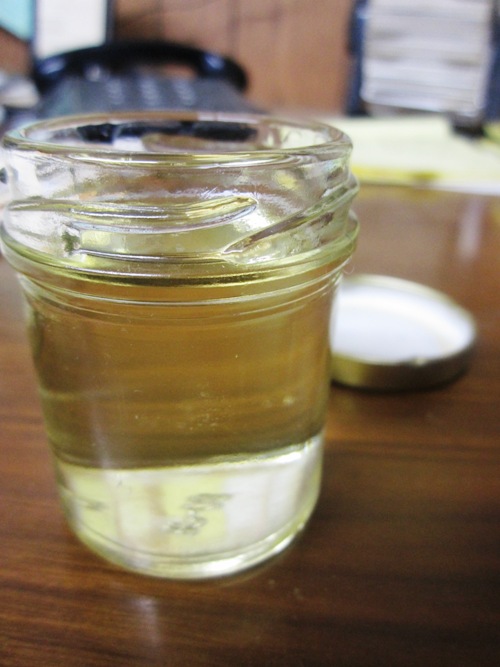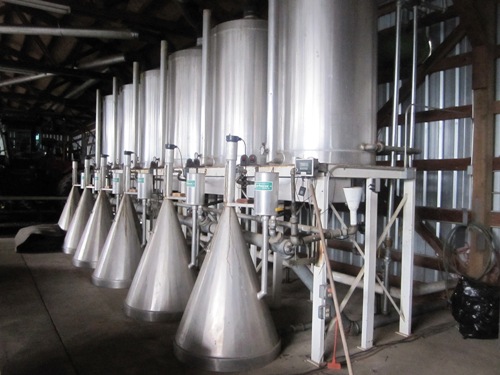Peppermint oil distillation takes place immediately after mint harvest at Butler Farms. The diesel powered boiler is the heart of the operation. It creates the steam that travels through the manifold and stainless steel lines into the just harvested mint hay tubs. The mint oil is extracted by the steam and channeled through stainless pipes to the condenser. As the steam cools in the condenser it liquefies and collects in the receding cans. Then by virtue of the fact that oil is lighter than water the oil naturally separates and is poured off into barrels.
For every acre of peppermint that the Butlers cultivate, they process roughly 90 to 100 pounds of peppermint oil, which translates to 40,000 pounds of peppermint oil a year. It takes a mere pound of the extremely potent oil to flavor 55,000 sticks of gum.
There are currently 21,000 acres devoted to mint oil production in Oregon grown by 150 farms, according to Bryan Ostlund of the Oregon Mint Commission. Nearly 70 percent of all peppermint grown in-state, in fact, is distilled into peppermint oil. That’s a lot of gum.
Of course, it doesn’t all become an ingredient in gum. Flavor houses purchase Butler Farms’ peppermint oil from a handler, and in turn sell it to oral care, candy and medical companies such as Colgate, Wrigley, Procter & Gamble and Pfizer.
Ostlund says that the recent history of Oregon mint oil production isn’t entirely rosy. Due to rapid changes in the retail business in the 1990s, “the pressure was on, and still is on, to cheapen products,” he notes. According to Ostlund, many of the older flavor house dependent companies continue to value high quality oil, especially with their older products particularly food and candy products. But, he adds, “Companies with new products coming into production, generally are not putting as high of a priority on quality ingredients. That’s usually when cheaper and inferior foreign mint oil comes into the equation. Essentially, companies are dumbing down their ingredients.”
The Willamette Valley has the highest flavor profile quality of peppermint oil in state. It is exceptionally bright and distinct with a nice level of menthofuran (a potent component of mint oil) which is why companies such as Atkinson Candy Company in Lufkin, Texas use it almost exclusively. Other Oregon mint production regions generally produce mint that doesn’t stand alone and requires blending.
Peppermint oil from India, China and South America is often significantly cheaper than domestic peppermint oil but that is of inferior quality. Says Butler, “It all comes down to the consumer. The consumer tells the Wrigleys and Wal-Marts and Costcos what they want; and the superstores tell the flavor houses what they want. Sure they want quality but they also want it cheap. That’s the way it is with all agricultural commodities.”
Despite this sort of cost-cutting and disregard for quality Butler Farms has no plans to slow down its mint oil production. And why should they? According to Bruce Pokarney, director of communication for Oregon Department of Agriculture, Oregon is the second leading US producer of peppermint and peppermint is ranked #15 of all Oregon commodities in value. Tim Butler is proud to cultivate such an important Oregon commodity. If in upcoming years we as a state can find a way to market Oregon-grown mint oil as a stand alone ingredient these numbers and percentages will likely grow. Maybe we'll even become the number one peppermint producer in the country.
Stay tuned for the last installment of this story.Read Pt. 1 Oregon MintRead Pt. 2 Oregon Mint


